Arts and Crafts
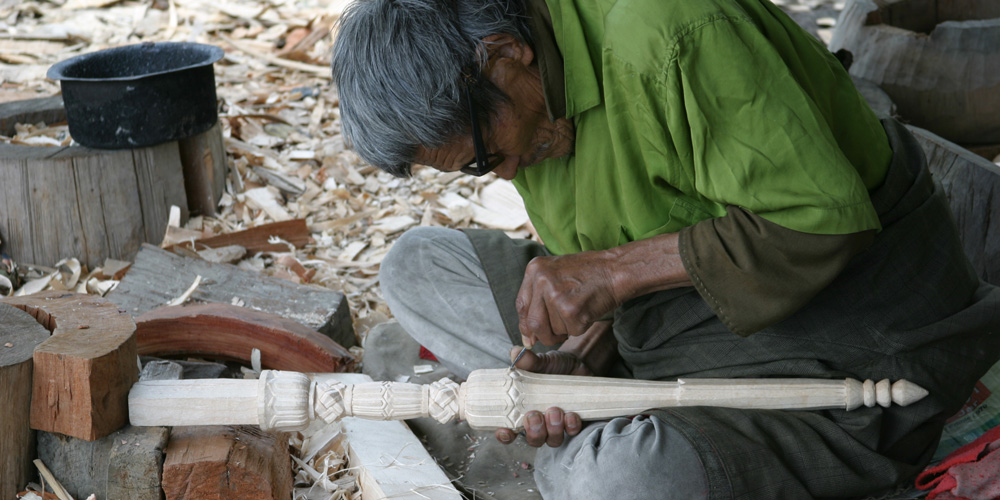
An essential part of Bhutan’s cultural heritage are the thirteen traditional arts and crafts that have been practiced from time immemorial. These arts were formally categorized during the reign of Gyalse Tenzin Rabgay, the fourth temporal ruler of Bhutan.
Zorig Chusum: The Thirteen Traditional Crafts of Bhutan
The thirteen arts and crafts are categorized as follows:
Thag-zo
The textile industry is an integral part of Bhutanese life and culture. As such the art of weaving is widely practiced.
Women of eastern Bhutan are skilled at weaving and some of the most highly prized textiles are woven by them. In the past, textiles were paid as a form tax to the government in place of cash and people from western Bhutan travelled all the way to Samdrup Jongkhar to acquire/barter for woven textiles. Bhutanese textiles are woven from cotton, raw cotton and silk with intricate motifs woven into the cloth.
Tsha-zo
Most of the forests in Bhutan are richly stocked with bamboos and canes of various species.
Taking advantage of these abundant natural resources, the Bhutanese people have mastered the skill of weaving cane and bamboo products. Widely known as Tshar Zo, this art is spread throughout the country and products such as baskets, winnowers, mats, containers known as Palangs and bangchungs are all made. The people of Kangpara in eastern Bhutan and the Bjokaps of Central Bhutan are the pioneer’s and masters of this craft. Their products are now sold to tourists earning them additional income and keeping this craft alive.
Shag-zo
The art of wood turning is known as Shag-Zo and is traditionally practiced by the people of Trashiyangtse in eastern Bhutan.
The master craftsmen of this vibrant art are known as Shag Zopa. They are famed for the wooden cups and bowls traditionally known as dapas and phobs. These wooden bowls are made of special wooden knots known as Zaa and are highly valued. Until the advent of steel and brass, these bowls were widely used by the Bhutanese. Today they are typically sold at craft markets and offered as gifts.
Lha-zo
Bhutanese paintings are quintessential of the arts and crafts tradition known as Lha-zo.
An ancient art that has been practiced since antiquity, paintings captures the imagery of the Bhutanese landscape. Master painters are known as Lha Rips and their work is apparent in every architectural piece from the massive Dzongs to glorious temples and spiritual monasteries and even in modest Bhutanese homes.
Shing-zo
Shing-zo or carpentry plays a major part in the construction of Bhutan’s majestic fortresses or dzongs, temples, houses, palaces and bridges.
Do-zo
Do-zo is the ancient craft of masonry, a trade which is still practiced today.
In Bhutan, temples, Dzongs, Chortens (or stupas) and farm-houses are all constructed using stone. Classic examples of stone work are those of Chorten Kora in Tashiyangtse in eastern Bhutan and Chendebji chorten in central Bhutan.
Par-zo
Par zo is the art of carving and another traditional Bhutanese art form that has been perfected over generations.
Major carvings are carried out on stone, wood and slate. The traditional designs crafted on these materials create beautiful and distinctive art works unique to the Land of the Thunder Dragon.
Jim zo
Jim zo or clay work is an ancient craft that has been practiced and passed down over the centuries.
This art form preceded other sculpture works such as bronze and other metal works. Statues of deities, gods and goddesses and other prominent religious figures exemplify clay work in Bhutan.
Lug-zo
Between the Stone Age and the Iron Age we have the Bronze Age around about 3500 BC.
Bronze was commonly used to cast containers such as cups, urns, and vases. People also shaped bronze into weapons and armor such as battle-axes, helmets, knives, swords and shields. Bronze casting in Bhutan was introduced only in the 17th century and was mainly spread through the visiting Newari artisans that came from Nepal. The Newars were first invited by Zhabdrung Nawang Namgyal to cast bronze statues and religious items such as bells and water offering bowls. It was through these artisans that the art was introduced and today, quite a few Bhutanese practice bronze casting.
Gar-zo
The art of iron work is known as Gar-zo and blacksmithing in Bhutan began sometime in the late 14th century.
It is believed that it was introduced by a Tibetan saint known as Dupthob Thangtong Gyalpo. He is revered by the Bhutanese people as a master engineer for his skill in casting iron chains and erecting them as bridges over gorges. He is supposed to have built eight suspension bridges in Bhutan.
Troe-ko
The vibrant craft of traditional ornament making is still designed today and is known as Troe ko.
Its products are widely used by Bhutanese women. A master craftsman skilled in shaping beautiful ornaments is regarded as Tro Ko Lopen. Using precious stones and metals such as corals, turquoise, silver and gold, these master craftsmen create all manner of ornaments and implements including necklaces, bangles, earrings, rings , brooches, amulets to contain ritual objects, traditional containers to carry the much chewed beetle nut, ritual objects and much more.
De-zo
Paper-making is another art that has deep roots in Bhutan. People engaged in producing the traditional Bhutanese paper or De zo are known as Dezop.
This traditional paper is made from the bark of the Daphne tree and was widely used in the past. Most religious scriptures and texts were written on Dezho using traditional Bhutanese ink or occasionally in gold. While the presence of readily available modern paper has overtaken the market, people still produce and use Desho as carry bags, wrapping for gifts and envelopes. The art still continues in Trashiyangtse where the raw material is readily available.
Tshem zo
Tshem zo or the art of tailoring is a popular art amongst the Bhutanese.
This art can be broadly classified as Tshem drup the art of embroidery, lhem drup the art of appliqué and Tsho lham, the art of traditional Bhutanese boot making. The art of embroidery and appliqué are normally practiced by monks. Using this art they produce large religious scrolls known as Thangkas that depicts Gods and Goddesses, deities and saints.
Climatic
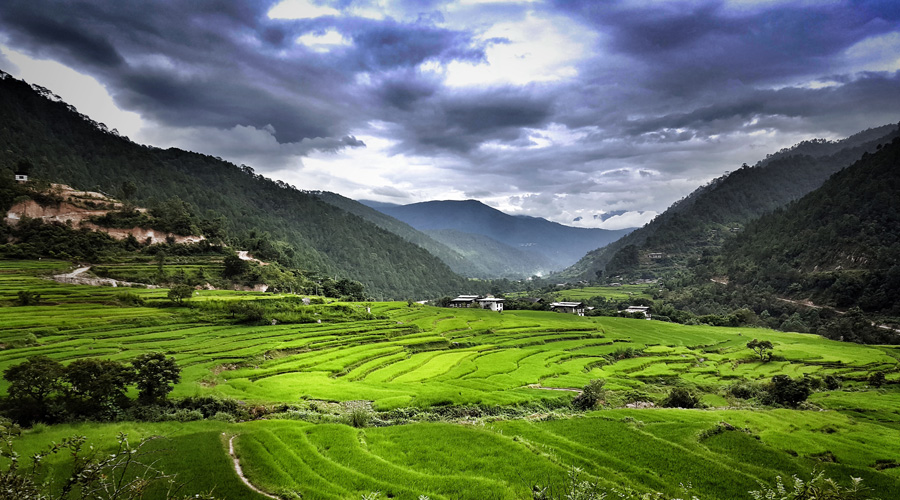
The climate in Bhutan is extremely varied. This variation in the climatic conditions and average temperature can be attributed to two main factors, the vast differences in altitude present in the country and the influence of the north Indian monsoons.
Southern Bhutan has a hot, humid sub-tropical climate that is fairly unchanging throughout the year. Temperatures can vary between 15-30 degrees Celsius. In the Central parts of the country the climate cools a bit, changing to temperate and deciduous forests with warm summers and cool, dry winters. In the far Northern reaches of the kingdom the weather is cold during winter. Mountain peaks are perpetually covered in snow and lower parts are still cool in summer owing to the high altitude terrain.
The Indian summer monsoon lasts from late-June through late-September and is mostly confined to the southern border region of Bhutan. It brings heavy rain and high humidity, to the southern region. These rains bring between 60 and 90 percent of the western region’s rainfall.
Annual precipitation ranges widely in various parts of the country. In the northern border region to Tibet gets about forty millimeters of precipitation a year which is primarily snow. In the temperate central regions, a yearly average of around 1,000 millimeters is more common, and 7,800 millimeters per year has been registered at some locations in the humid, subtropical south, ensuring the thick tropical forest, or savanna.
Thimphu experiences dry winter months (December through February) and almost no precipitation until March, when rainfall averages 20 millimeters a month and increases steadily thereafter to a high of 220 millimeters in August for a total annual rainfall of nearly 650 millimeters.
Bhutan’s generally dry spring starts in early March and lasts until mid-April. Summer weather commences in mid-April with occasional showers and continues to late June. The heavier summer rains last from late June through late September which are more monsoonal along the southwest border.
Autumn, from late September or early October to late November, follows the rainy season. It is characterized by bright, sunny days and some early snowfalls at higher elevations.
From late November until March, winter sets in, with frost throughout much of the country and snowfall common above elevations of 3,000 meters. The winter northeast monsoon brings gale-force winds at the highest altitudes through high mountain passes, giving Bhutan its name – Drukyul, which in the Dzongkha language mean Land of the Thunder Dragon.
Culture
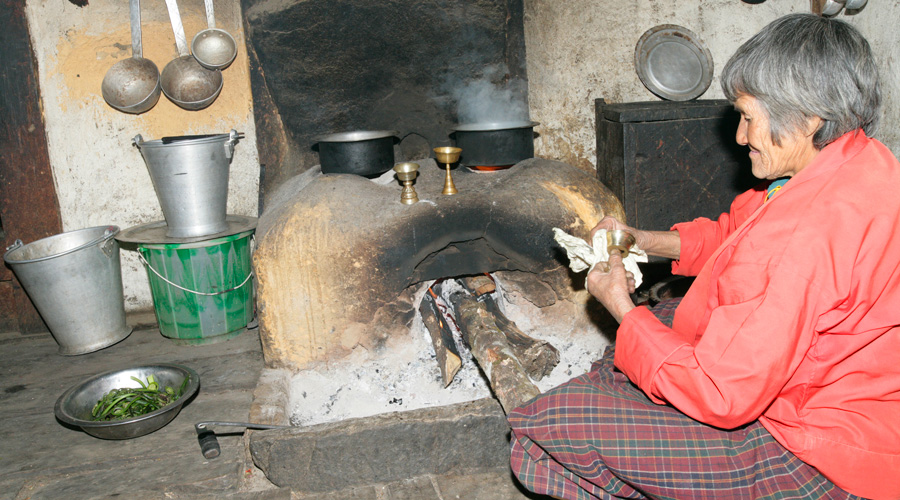
While Bhutan is one of the smallest countries in the world, its cultural diversity and richness are profound. As such, strong emphasis is laid on the promotion and preservation of its unique culture. By protecting and nurturing Bhutan’s living culture it is believed that it will help guard the sovereignty of the nation.
Eating Habits
Traditional Bhutanese eating habits are simple and, in general, food is eaten with hands. Family members eat while sitting cross legged on the wooden floor with food first being served to the head of the household first.
Traditionally dishes were cooked in earthenware, but with the easy availability of modern goods, pots and pans have largely replaced their use. A typical Bhutanese meal consists of rice, a dish of Ema Datshi, the country’s favourite dish of chili and cheese, pork, beef curry or lentils.
Funeral
Death signifies re-birth or a mere passing on to a new life. In keeping with the traditions, elaborate rituals are performed to ensure a safe passage and a good rebirth.
Bhutanese typically bury their dead while the Brokpas carry out ‘Sky Burials’, a process in which the deceased are prepared and left atop mountains to be devoured by vultures in a final act of compassion and generosity. Elaborate and ancient rituals are also conducted on the anniversary of the death with the erection of prayer flags. The relatives and people of the locality come with alcohol, rice or other sundry items to attend such rituals.
Birth
The birth of a child is always welcomed. In Bhutan extended family and guests are discouraged from visiting during the first three days after the birth.
The child is not immediately named; this responsibility is usually entrusted to the head lama (Buddhist priest) of the local temple. The mother and child will also receive blessings from the local deity (natal deity) and it was traditional that the name associated with the deity is given. In some cases, the child is given the name of the day on which the child is born. Based on the Bhutanese calendar, a horoscope is written based on the time and date of the birth, this will detail the various rituals to be performed at different times in the life of the child and to an extent predict his or her future.
Marriage
Until just a few decades ago arranged marriages were common and many married among their relatives. In eastern Bhutan cross-cousin marriages were also once common, however, this practice is now becoming less common place among the literate masses and most marriages are based on the choice of the individuals.
Marriages are simple affairs and are usually kept low-key. However, elaborate rituals are performed for lasting unions between the bride and the bridegroom. As the religious ceremony comes to an end, parents, relatives and friends of the couple present the newlyweds with traditional offerings of scarves along with gifts in the form of cash and goods.
Bhutanese Dress
One of the most distinctive features of the Bhutanese is their traditional dress.
One of the most distinctive features of the Bhutanese is their traditional dress, unique garments that have evolved over thousands of years. Men wear the Gho, a knee-length robe somewhat resembling a kimono that is tied at the waist by a traditional belt known as Kera. The pouch t which forms at the front traditionally was used for carrying food bowls and a small dagger. Today however it is more accustomed to carrying small articles such as wallets, mobile phones and Doma (beetle nut).
Women wear the Kira, a long, ankle-length dress accompanied by a light outer jacket known as a Tego with an inner layer known as a Wonju.
Festivals
Bhutan is rich in cultural diversity and this richness is further enhanced by the wide variety of elaborate and colorful religious festivals that are celebrated throughout the country. Every village is known for their unique festival though the most widely known is the annual Tshechu, meaning a religious festival.
As the Tshechu begins, the villagers and the general populace dress in their finest clothes and congregate at their local temples and monasteries were these festivals take place. Tshechus are usually occasions to mark important events in the life of the second Buddha, the Indian/Pakistani Tantric master known as Guru Rinpoche or the Precious Gem. Various mask dances are performed together with songs and dances for three days.
Economy
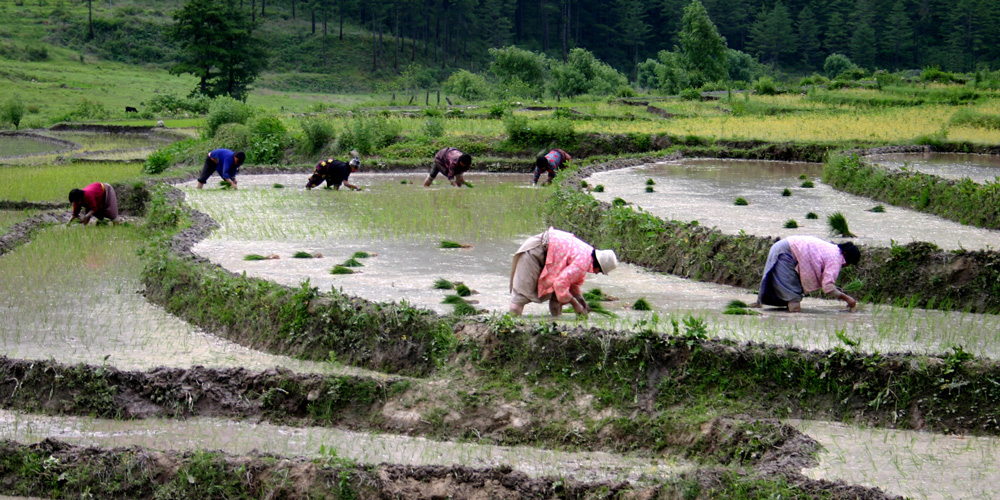
Despite Bhutan’ small population there has been much economic development in recent years and the economy is growing rapidly.
While a large part of the Bhutanese population is still illiterate and reside in rural areas with approximately 1 in 5 still living under the poverty line, the majority of all Bhutanese have shelter and are self-sufficient. Rapid modernization has brought about vast improvements in the living standard of the Bhutanese people. All villages now have access to basic amenities such as education, running water, basic healthcare and are connected by roads and electricity. Even the most remote villages have connection to the telecommunication network including mobile phone service.
The Bhutanese economy is predominantly agricultural. Farmers supplement their income through the sale of animal products such as cheese, butter and milk. Farmers’ markets are common throughout the country, supplying the people with fresh, organic, local produce.
The main staple crops are rice, maize, wheat and buckwheat while cash crops are predominantly potatoes, apples, oranges, cardamom, ginger, and chilies. A fruit based industry has been established in the capital allowing farmers from the nearby areas to sell their produce and thereby earn additional revenue.
Cottage Industries
Bhutan’s rich biodiversity provides the country with ample forest resources and this has brought about the development of a thriving cane and bamboo handicraft industry. Craftsmen weave a number of beautiful and intricate items out of bamboo and cane including hats, backpacks, floor mats and traditional bowls. These items are then sold to tourists or Bhutanese, supplying a secondary income source.
Tourism
The Bhutanese Tourism Industry was first opened in 1974. Since then it has grown to become, a major contributing factor to the Bhutanese economy creating countless employment opportunities and generating additional revenue for the government.
The government is committed to building a sustainable tourism industry that is not only financially viable but also limits the negative cultural and environmental impacts commonly associated with the culture of mass tourism. By establishing a policy of “High Value, Low Impact’ tourism, the kingdom of Bhutan seeks to ensure that it attracts only the most discerning visitors with a deep respect for cultural values, traditions and the natural environment.
To this end efforts have been made to ensure that even remote areas are publicized and able to reap the benefits of tourism while still respecting their traditions, culture and natural environment.
Hydroelectricity
Due to its fast flowing, glacier-fed rivers, Bhutan has enormous potential to produce hydroelectricity. With the construction of several major dams, the power sector has undeniably been the biggest contributor to the Bhutanese exchequer. The Chukha Hydro Power Corporation, the Tala Hydro Power Corporation, the Baso Chu Hydro Power Corporation and the Kurichu Hydro Power Corporation, under the umbrella of Druk Green Power Corporation, are some of the existing mega projects in the country. The 1500 MW of power they generate, most of which is exported to our neighboring country India, barely scratches the surface of Bhutan’s untapped hydroelectric potential. With its abundant water resources, Bhutan still has the capacity to generate another 30,000 MW of electricity. However, the government is proceeding cautiously with new construction projects in order to minimize the impact upon the surrounding areas.
Manufacturing
The Manufacturing sector is another major contributor to national revenue. With the industrial sector established in Pasakha, small scale industries such as cement plants, calcium and carbide, steel and Ferro silicon, Coca Cola and also wood based industries have started developing.
As a result of the recent economic development, Bhutan has one of the highest per capita incomes in South Asia at US$1,321. However despite this high level of growth and development, efforts stringent regaliations have been enacted in order to protect Bhutan’s natural environment.
Environment
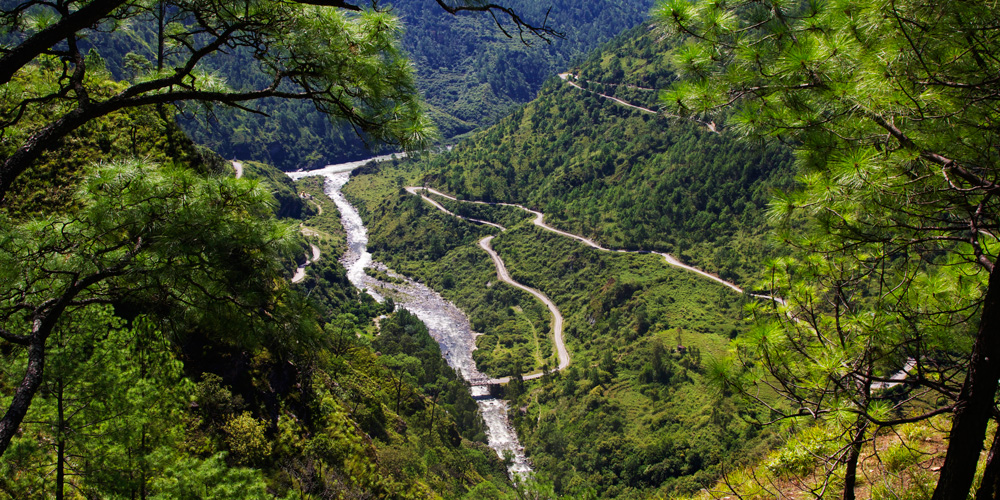
Due to Bhutan’s location and unique geographical and climatic variations, it is one of the world’s last remaining biodiversity hotspots.
Bhutan pristine environment, with high rugged mountains and deep valleys, offers ecosystems that are both rich and diverse. Recognizing the importance of the environment, conservation of its rich biodiversity is one of the government’s development paradigms.
The government has enacted a law that shall maintain at least 60% of its forest cover for all time. Today, approximately 72% of the total land area of Bhutan is under forest cover and approximately 60% of the land area falls under protected areas comprising of 10 national parks and sanctuaries.
National Parks and Wildlife Sanctuaries
Each of Bhutan’s National Parks and Wildlife Sanctuaries are an essential part of the Bhutan Biological Conservation Complex – a system of national parks, protected areas and forest corridors covering 60% of the country. Each of these parks and sanctuaries has its own special character and are home to endangered animals, birds and plants.
Festivals
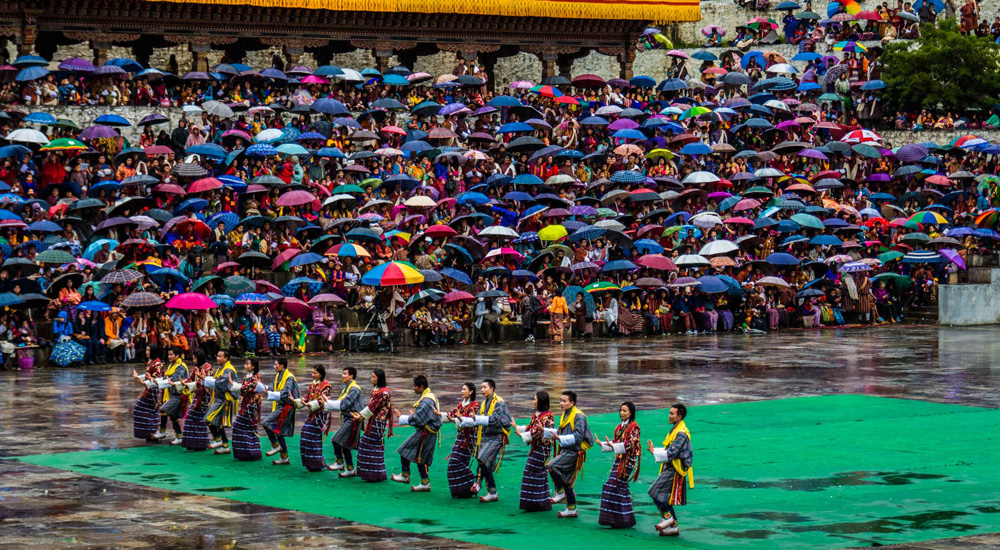
Tsechus are the most popular festival in Bhutan. It is a spiritual social event celebrated annually across the country. The festival honors Guru Rinpoche. Guru Rinpoche is believed to have introduced Buddhism in Bhutan. Tsechus are organized in the courtyard within or around the majestic medieval fortresses. The monks are seen wearing colorful silk costume and their faces cloaked with intricately hand crafted mask. The mask depict terrifying pantheon of deities. The monks perform a series of religion inspired dances which includes a theatrical presentation of the afterlife and the judgment day.
During these festivals, it is a tradition for locals to dress ostentatiously and cook sumptuous food for the event. It is believed that the sacred masked dances invoke deities to bless the congregation. The festival usually lasts several days. The final day of a Tsechu is marked by the unfurling of a gigantic applique scroll painting depicting Guru Rinpoche before the break of dawn. Locals believe that the applique painting has the power to cleanse bad karma of anyone who catches a glimpse of the painting. The painting is only open to public display during the Tsechu.
Flora & Fauna
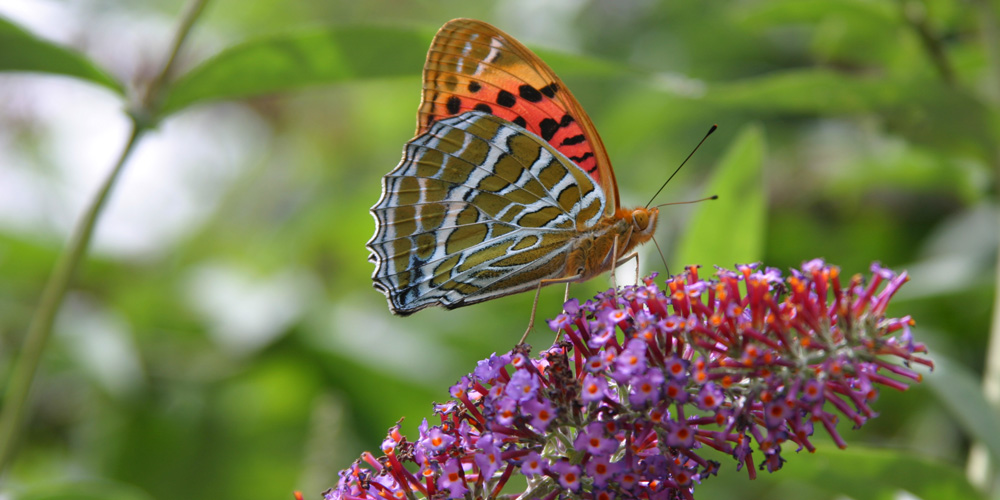
Bhutan is one of the last remaining biodiversity hotspots in the world, forest cover has now increased to over 72% of the country, with 60% of the country under protection.
The array of flora and fauna available in Bhutan is unparalleled due to conservation and its wide altitudinal and climatic range. Physically, the country can be divided into three zones:
1. Alpine Zone (4000m and above) with no forest cover;
2. Temperate Zone (2000 to 4000m) with conifer or broadleaf forests;
3. Subtropical Zone (150m to 2000m) with Tropical or Subtropical vegetation.
Forest types in Bhutan are fir forests, mixed conifer forest, blue pine forest, chirpine forest, broadleaf mixed with conifer, upland hardwood forest, lowland hardwood forest, and tropical lowland forests. Almost 60% of the plant species found in the eastern Himalayan region are present in Bhutan.
Bhutan boasts of about 300 species of medicinal plants and about 46 species of rhododendrons. Some common sights for the visitors are the magnolias, junipers, orchids of varied hues, gentian, medicinal plants, Daphne, giant rhubarb, the blue and trees such as fir, pine and oaks.
A wide range of rare and endangered animals can also be found frequenting the dense jungles and high mountains of Bhutan. Due to the countries conservation efforts and its unspoiled natural environment Bhutan supports thriving populations of some of the rarest animals on earth and has thus been classified as one of the last biodiversity hotspots in the world.
Some high altitude species are the snow leopards, Bengal tigers that are found at altitude ranging 3000 to 4000 meters, the red panda, the gorals and the langurs, the Himalayan black bear, sambars, wild pigs, barking deer, blue sheep and musk deer.
In the tropical forests of Southern Bhutan one can come across clouded leopards, the one horned rhinoceros, elephants, water buffaloes and swamp deer. You can even find the Golden Langur, a species of monkey that is unique to Bhutan.
Bhutan also has a great variety of bird species. It is recognized as an area of high biological diversity and is known as the East Himalayan ‘hot spot’, the hub of 221 global endemic bird areas. The recorded number of bird species is over 670 and is expected to rise as new birds are discovered.
In addition, 57% of Bhutan’s globally threatened birds and 90% of the country’s rare birds are dependent on forests. Bhutan has about 415 resident bird species. These birds are altitudinal refugees, moving up and down the mountains depending upon the seasons and weather conditions. Of about 50 species of birds that migrate during the winters are the buntings, waders, ducks, thrushes and the birds of prey. Some 40 species are partial migrants and they include species such as swifts, cuckoos, bee-eaters, fly catchers and warblers.
Bhutan is also home to about 16 bird species that are endangered worldwide. These include the White bellied heron, Pallas Fish eagle and Blyth’s King fisher to name a few. Phobjikha valley in Wangdue Phodrang and Bomdeling in Trashi Yangtse are also two especially important locations of the endangered Black Necked Cranes.
As one of the ten global hotspots, Bhutan is committed to preserve and protect its rich environment through its government and environmental organizations. This commitment is apparent in the fact that the kingdom has the distinct honor of being one of the only nations whose forest cover has actually grown over the years.
Foods
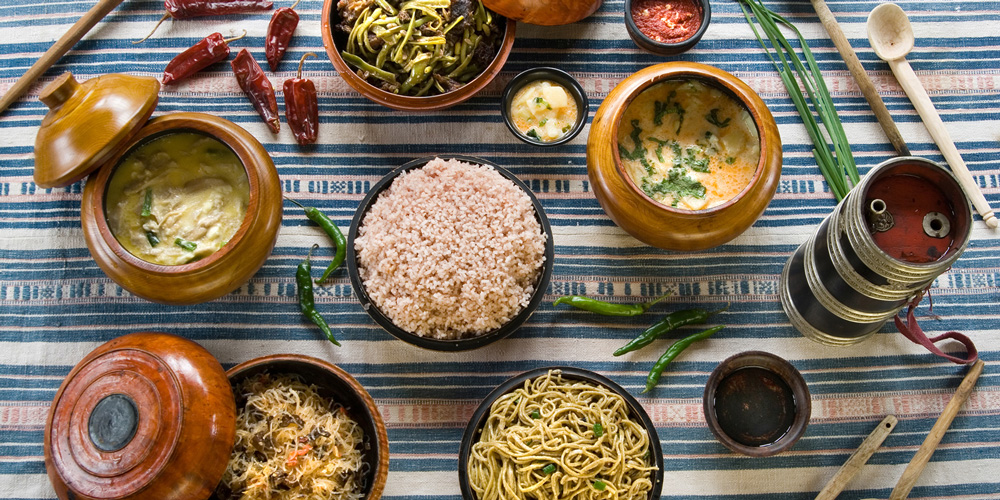
The most distinctive characteristic of Bhutanese cuisine is its spiciness. Chillis are an essential part of nearly every dish and are considered so important that most Bhutanese people would not enjoy a meal that was not spicy.
Rice forms the main body of most Bhutanese meals. It is accompanied by one or two side dishes consisting of meat or vegetables. Pork, beef and chicken are the meats that are eaten most often. Vegetables commonly eaten include Spinach, pumpkins, turnips, radishes, tomatoes, river weed, onions and green beans. Grains such as rice, buckwheat and barley are also cultivated in various regions of the country depending on the local climate.
The following is a list of some of the most popular Bhutanese dishes:
Ema Datshi
This is the National Dish of Bhutan. A spicy mix of chillis and the delicious local cheese known as Datshi. This dish is a staple of nearly every meal and can be found throughout the country. Variations on Ema Datshi include adding green beans, ferns, potatoes, mushrooms or swapping the regular cheese for yak cheese.
Momos
These Tibetan-style dumplings are stuffed with pork, beef or cabbages and cheese. Traditionally eaten during special occasions, these tasty treats are a Bhutanese favourite.
Phaksha Paa
Pork cooked with spicy red chillis. This dish can also include Radishes or Spinach. A popular variation uses sun-dried (known as Sicaam). Hoentoe: Aromatic buckwheat dumplings stuffed with turnip greens, datshi (cheese), spinach and other ingredients.
Jasha Maru
Spicy minced chicken, tomatoes and other ingredients that is usually served with rice.
Red Rice
This rice is similar to brown rice and is extremely nutritious and filling. When cooked it is pale pink, soft and slightly sticky.
Goep (Tripe)
Though the popularity of tripe has diminished in many countries it is still enjoyed in Bhutan. Like most other meat dishes, it is cooked with plenty of spicy chillis and chilli powder.
Gross National Happiness
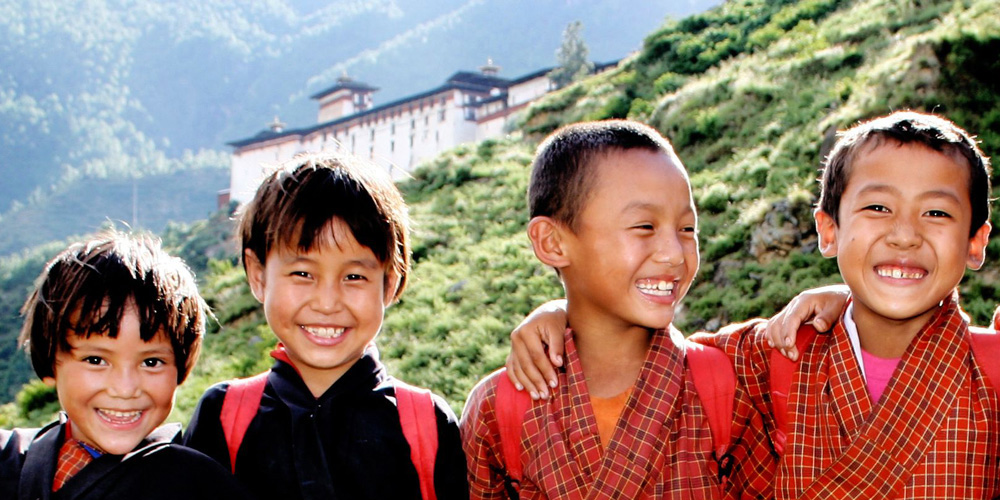
Development Philosophy of Bhutan
Economists the world over have argued that the key to happiness is obtaining and enjoying material development. Bhutan however, adheres to a very different belief and advocates that amassing material wealth does not necessarily lead to happiness. Bhutan is now trying to measure progress not by the popular idea of Gross Domestic Product but by through Gross National Happiness.
His Majesty the third Druk Gyalpo Jigme Dorji Wangchuck expressed his view on the goals of development as making “the people prosperous and happy.” With this strong view in mind, the importance of “prosperity and happiness,” was highlighted in the King’s address on the occasion of Bhutan’s admission to the United Nations in 1971.
While the emphasis is placed on both, prosperity and happiness, the latter is considered to be more significant. The fourth Druk Gyalpo emphasized that for Bhutan “Gross National Happiness,” is more important than “Gross National Product.” Thus, Gross National Happiness is now being fleshed out by a wide range of professionals, scholars and agencies across the world.
Druk Gyalpo Jigme Singye Wangchuck said that the rich are not always happy while the happy generally considered themselves rich. While conventional development models stressed on economic growth as the ultimate objective, the concept of Gross National Happiness is based on the premise that true development of human society takes place when material and spiritual development occur side by side to complement and reinforce each other.
The philosophy of Gross National Happiness has recently received international recognition and the UN has implemented a resolution ” recognizing that the gross domestic product does not adequately reflect the happiness and well-being of people,” and that the pursuit of happiness is a fundamental human goal”.
The four main pillars of Gross National Happiness are:
1. Equitable and equal socio-economic development
2. Preservation and promotion of cultural and spiritual heritage
3. Conservation of environment and
4. Good governance which are interwoven, complementary, and consistent.
These pillars embody national and local values, aesthetics, and spiritual traditions. The concept of Gross National Happiness is now being taken up the United Nations and by various other countries.
Crucial to a better understanding of Gross National Happiness, is its wider reach and awareness amongst other countries, and the various indices that have now been formulated to include material gains in their assessment of the country and lastly, the growing need to synthesize the moral with the cultural values as the core of economic policy.
Gross National Happiness as a development paradigm has now made it possible for Bhutan to take its developmental policies into the remote corners of the kingdom and to meet the development needs of even its most isolated villagers, while still accentuating the need to protect and preserve our rich environment and forest cover. The policy of high value, low impact tourism has facilitated the promotion and preservation of our cultural values.
Furthermore, the concept of Gross National Happiness has greatly enabled the pursuit of development, while at the same time promoting the attainment of happiness as the core philosophy of life. For the government, it has facilitated the drive towards self sufficiency and self reliance, the ultimate reduction in the gap between the rich and the poor and ensuring good governance and empowerment of her people as one of its key directives.
History
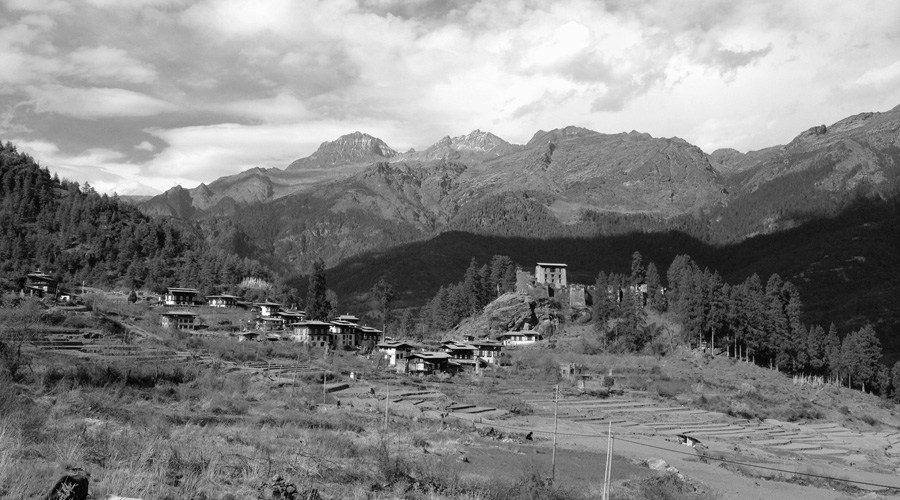
It is believed that Bhutan was inhabited as early as 2000 B.C. due to the presence of early stone implements discovered in the region.
The country was originally known by many names including Lho Jong, ‘The Valleys of the South’, Lho Mon Kha Shi, ‘The Southern Mon Country of Four Approaches’, Lho Jong Men Jong, ‘The Southern Valleys of Medicinal Herbs and Lho Mon Tsenden Jong, ‘The Southern Mon Valleys where Sandlewood Grows’. Mon was a term used by the Tibetans to refer to Mongoloid, non-Buddhist peoples that populated the Southern Himalayas.
The country came to be known as Druk Yul or The Land of the Drukpas sometime in the 17th century. The name refers to the Drukpa sect of Buddhism that has been the dominant religion in the region since that period.
Initially Bonism was the dominant religion in the region that would come to be known as Bhutan. Buddhism was introduced in the 7th century by the Tibetan King Songtsen Gampo and further strengthened by the arrival of Guru Rimpoche, a Buddhist Master that is widely considered to be the Second Buddha.
The country was first unified in 17th century by Zhabdrung Ngawang Namgyel. After arriving in Bhutan from Tibet he consolidated his power, defeated three Tibetan invasions and established a comprehensive system of law and governance. His system of rule eroded after his death and the country fell into in-fighting and civil war between the various local rulers. This continued until the Trongsa Poenlop Ugyen Wangchuck was able to gain control and with the support of the people establish himself as Bhutan’s first hereditary King in 1907. His Majesty Ugyen Wangchuck became the first Druk Gyalpo (Dragon King) and set up the Wangchuck Dynasty that still rules today.
In 2008 Bhutan enacted its Constitution and converted to a democracy in order to better safeguard the rights of its citizens. Later in November of the same year, the currently reigning 5th Druk Gyalpo Jigme Khesar Namgyel Wangchuck was crowned.
Language
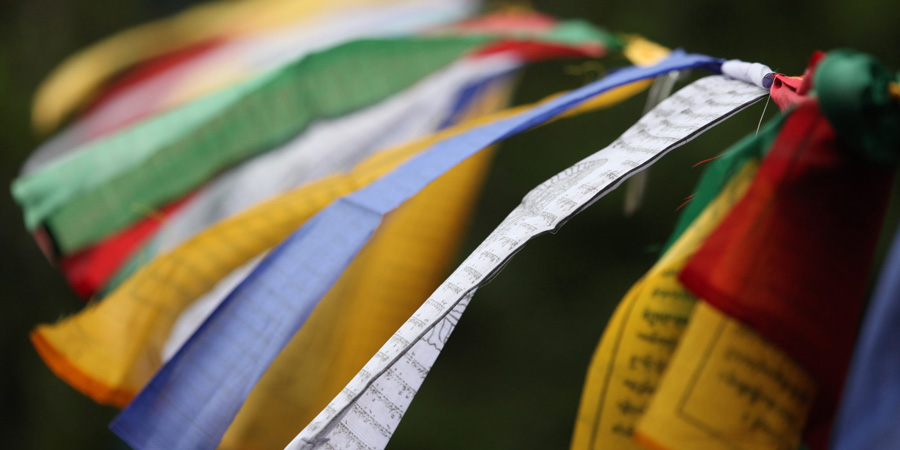
Bhutan is linguistically rich with over nineteen dialects spoken in the country. The richness of the linguistic diversity can be attributed to the geographical location of the country with its high mountain passes and deep valleys. These geographical features forced the inhabitants of the country to live in isolation but also contributed to their survival.
The national language is Dzongkha, the native language of the Ngalops of western Bhutan. Dzongkha literally means the language spoken in the Dzongs, massive fortresses that serve as the administrative centers and monasteries. Two other major languages are the Tshanglakha and the Lhotshamkha. Tshanglakha is the native language of the Tshanglas of eastern Bhutan while Lhotshamkha is spoken by the southern Bhutanese of Nepali origin.
Other dialects spoken are Khengkha and Bumthapkha by the Khengpas and Bumthap people of Central Bhutan. Mangdepkah, which is spoken by the inhabitants of Trongsa and the Cho Cha Nga Chang Kha which is spoken by the Kurtoeps. The Sherpas, Lepchas and the Tamangs in southern Bhutan also have their own dialects. Unfortunately two dialects that are on the verge of becoming extinct are the Monkha and the Gongduepkha.
People
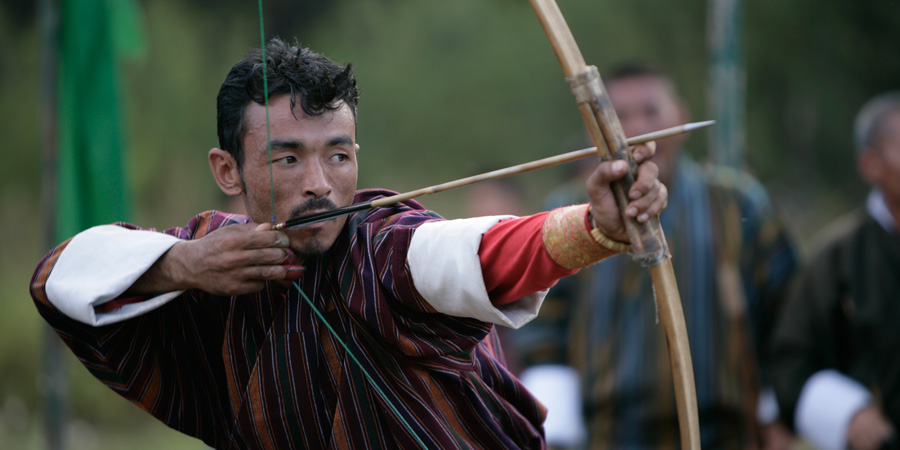
Bhutanese people can be generally categorized into three main ethnic groups. The Tshanglas, Ngalops and the Lhotshampas.
The other minority groups are the Bumthaps and the Khengpas of Central Bhutan, the Kurtoeps in Lhuentse, the Brokpas and the Bramis of Merak and Sakteng in eastern Bhutan, the Doyas of Samtse and finally the Monpas of Rukha villages in WangduePhodrang. Together the multiethnic Bhutanese population number just over 700,000.
Tshanglas
The Tshanglas or the Sharchops as they are commonly known, are considered the aboriginal inhabitants of eastern Bhutan. Tshanglasare according to historians, the descendants of Lord Brahma and speak Tshanglakha. They are commonly inhabitants of Mongar, Trashigang, Trashiyangtse, Pema Gasthel and Samdrup Jongkhar. Besides cultivation of maize, rice, wheat, barley and vegetables, the Tshanglas also rear domestic animals to supplement their living. Weaving is a popular occupation among their women and they produce beautiful fabrics mainly of silk and raw silk.
Ngalops
The Ngalops who have settled mostly in the six regions of western Bhutan are of Tibetan origin. They speak Ngalopkha, a polished version of Dzongkha, the national language of Bhutan. Agriculture is their main livelihood. They cultivate cereals such as rice, wheat, barley and maize along with a variety of other crops. In the regions of Thimphu and Paro apples are also cultivated as a cash crop. They are known for Lozeys, or ornamental speech and for Zheys, dances that are unique to the Ngalops.
Lhotshampas
The Lhotshampashave settled in the southern foothills of the country. It is believed that they migrated from Nepal in the beginning of the 19th century, attracted by the employment opportunities provided by the many constructions works taking place in the kingdom. They speak Lhotshamkha (Nepali) and practice Hinduism. Their society can be broken into various lineages such as the Bhawans, Chhetris, Rai’s, Limbus, Tamangs, Gurungs, and the lLepchas. Nowadays they are mainly employed in agriculture and cultivate cash crops like ginger, cardamom and oranges.
The Bumthaps, Mangdeps and Khengpas
The people who speak Bumtapkha, Mangdepkha and khengkha respectively inhabit the central areas of Bhutan. The Bumthaps cultivate buck wheat, potatoes and vegetables. A section of this population also rear yaks and sheep and produce fabrics of wool and yak hair. The Mangdeps depend on cultivation of rice, wheat, maize, vegetables, etc besides rearing domestic animals. The khengpas are also dependent on agriculture much like the Mangdeps, however, they are also known for the bamboo and cane craft.
Kurtoeps
Kurtoeps inhabit the eastern part of the country. Specifically the district of Lhuentse and the villages are found spread along the banks of Kurichu. Khoma women are expert weavers and are known for their skill in weaving the grandiose Kushithara.
The Brokpas and the Bramis
The Brokpas and the Bramis are a semi nomadic community. They are settled in the two villages of Merak and Sakteng in eastern Bhutan. They mostly depend on yaks and sheep for their livelihood and do not typically grow crops due to the high altitude zones they inhabit. They speak a different dialect and have their own unique dress that is made of yak hair and sheep wool. They are also experts in cane and bamboo crafts.
The Layaps
To the extreme north are the Layaps who speak layapkha. Like the Brokpas, they are semi-nomadic and their livelihood is dependent upon yaks and sheep. They use the products of their herd animals to barter rice, salt and other consumables with the people of WangduePhodrang and Punakha.
The Doyas
A tribal community that has settled mostly in southern Bhutan. They are considered the aboriginal inhabitants of western and central Bhutan, who over the years migrated to and settled in the present areas in Dorokha. They have their own unique dialect and style of dress.
Monpas
The Monpas are a small community in Rukha under WangduePhodrang. Together with the Doyas they are also considered the original settlers of central Bhutan. They have their own unique dialect but it is unfortunately slowly dying out as they are now being absorbed into the main stream Bhutanese society.
Political System of Bhutan
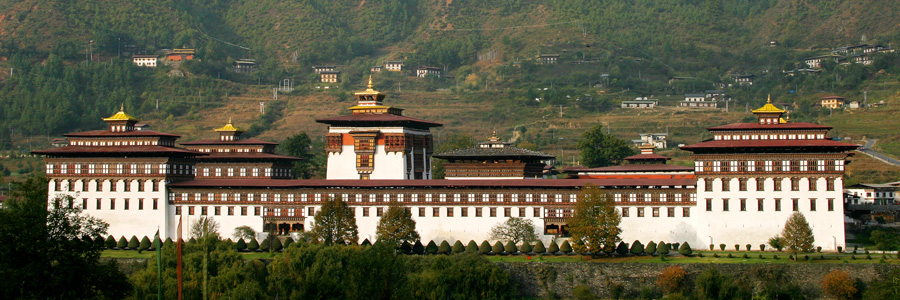
The political system of Bhutan has evolved over time together with its tradition and culture. It has developed from a fragmented and a disoriented rule of the different regions by local chieftains, lords and clans into the parliamentary democracy we have in place today.
The first move towards a systematic scheme of governance came in 1616 with the arrival of Zhabdrung Nawang Namgyal from Tibet. He introduced the dual system of governance with the Je Khenpo as the spiritual head of the nation and the Desis, as the head of the temporal aspects.
But a major breakthrough came about in 1907 when the people unanimously enthroned Ugyen Wangchuck as the fist hereditary King of Bhutan. He was the man who had proven his mettle by banding together the different Dzongpons and Penlops (governors of fortress), ending centuries of strife and bringing much needed stability and peace to the country. Since then, the country has been ruled by successive monarchs of the Wangchuck dynasty.
In a move to ensure a more democratic governance of the country, the Third King Jigme Dorji Wangchuck instituted the National Assembly (Tshogdu) in 1953. Every gewog has an elected member representing it in the National assembly. It became a platform where the people’s representatives enacted laws and discussed issues of national importance.
The establishment of the Royal Advisory Council (Lodoe Tshogde) in 1963 as a link between the king, council of ministers and the people was another move towards democratization. It also advised the king and the council of ministers on important issues and ensured that projects were implemented successfully.
The institution of Dzongkhag Yargay Tshogdu (District Development Assembly) in 1981 and Gewog Yargay Tshogchung (County Development Assembly) in 1991 by the Fourth King Jigme Singye Wangchuck was another move towards decentralization.
But the devolution of the power of the King in 1998 to the cabinet ministers was the highest form of decentralization. The King, thereafter, began to serve as the Head of the State while the government was managed by the Prime Minister.
In November 2001, on the advice of the Fourth king, a committee chaired by the Chief Justice of Bhutan, was formed to draft the constitution of Bhutan. The constitution was launched in 2008 and with it a parliamentary democracy introduced. The progression from Hereditary Monarchy to that of a Parliamentary Democracy has been a carefully managed process that culminated in 2008 when Bhutan held its first elections country wide. The Druk Phunsum Tshogpa was mandated by the people to head the new government with a major victory with 45 elected members, Lyonchen Jigme Y Thinley steered the government with just two opposition members from the People’s Democratic Party in 2008.The term of DPT (Druk Phuensum Tshogpa) has ended and people have chosen PDP (People’s Democratic Party) on 13th July 2013 as the new government.Today Tshering Tobgay is the Prime Minister of the new government.
The organs of the Bhutanese government comprise of the Legislature, Judiciary and the Executive. The ruling political party, the opposition and the National Council now forms the legislative body.
Religion
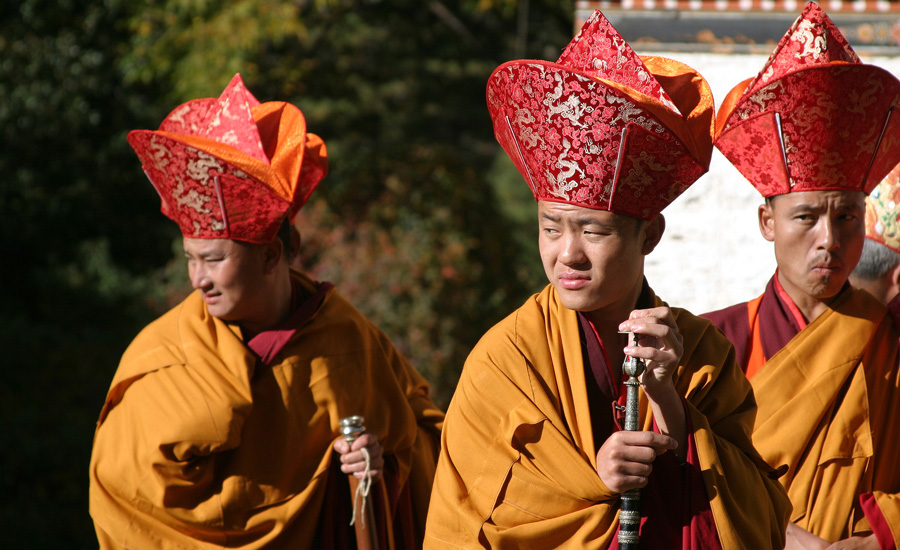
Buddhism
Bhutan is a Buddhist country and people often refer to it as the last stronghold of Vajrayana Buddhism. Buddhism was first introduced by the Indian Tantric master Guru Padmasambhava in the 8th century. Until then the people practiced Bonism a religion that worshipped all forms of nature, remnants of which are still evident.
Until then the people practiced Bonism a religion that worshipped all forms of nature, remnants of which are still evident even today in some remote villages in the country.
With the visit of Guru Padmasambhava, Buddhism began to take firm roots within the country and this especially led to the propagation of the Nyingmapa (the ancient or the older) school of Buddhism.
The Buddhism practiced in the country today is a vibrant religion that permeates nearly every facet of the Bhutanese life style. It is present in the Dzongs, monasteries, stupas, prayer flags, and prayer wheels punctuate the Bhutanese landscape. The chime of ritual bells, sound of gongs, people circumambulating temples and stupas, fluttering prayer flags, red robed monks conducting rituals stand as testaments to the importance of Buddhism in Bhutanese life.
Animism
Though Bhutan is often referred to as the last Vajrayana Buddhist country, you can still come across animistic traditions and beliefs being practiced by the people.
The form of Buddhism practiced in Bhutan has absorbed many of the features of Bonism such as nature worship and animal sacrifice. Also worship of a host of deities, invoking and propitiating them. According to Bonism these deities were the rightful owners of different elements of nature. Each different facet of nature was associated with its own specific type of spirit.
For example, mountain peaks were considered as the abodes of guardian deities (Yullha), lakes were inhabited by lake deities (Tshomem), cliff deities (Tsen) resided within cliff faces, the land belonged to subterranean deities (Lue and Sabdag), water sources were inhabited by water deities (Chu giLhamu), and dark places were haunted by the demons (due).
Society
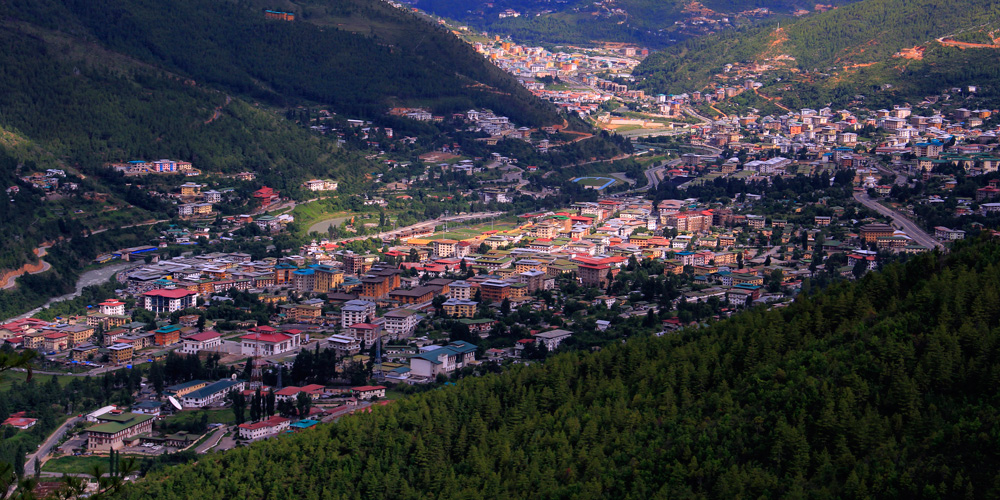
Bhutanese society is free of class or a caste system. Slavery was abolished by the Third King Jigme Dorji Wangchuck in the early 1950s through a royal edict. Though, a few organizations to empower women were established in the past Bhutanese society has always maintained relative gender equality. In general our nation is an open and a good-spirited society.
Living in Bhutanese society generally means understanding some accepted norms such as Driglam Namzha, the traditional code of etiquette. Driglam Namzha teaches people a code of conduct to adhere to as members of a respectful society. Examples of Driglam Namzha include wearing a traditional scarf (kabney) when visiting a Dzong or an office, letting the elders and the monks serve themselves first during meals, offering felicitation scarves during ceremonies such as marriages and promotions and politely greeting elders or seniors.
Normally, greetings are limited to saying “Kuzuzangpo” (hello) amongst equals. For seniors and elders, the Bhutanese bow their head a bit and say “kuzuzangpo la” (a more respectful greeting). Recently, shaking hands has become an accepted norm.
The Bhutanese are a fun-loving people fond of song and dance, friendly contests of archery, stone pitching, traditional darts, basketball and football. We are a social people that enjoy weddings, religious holidays and other events as the perfect opportunities to gather with friends and family.
The openness of Bhutanese society is exemplified in the way our people often visit their friends and relatives at any hour of the day without any advance notice or appointment and still receive a warm welcome and hospitality.